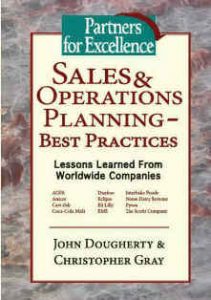 Chris Gray of Gray Research is a longtime contributor to the practice of Sales and Operations Planning. He is author of several books on S&OP, software selection, and other supply chain related areas, including Sales and Operations Planning Standard System (2007). In 2006 he co-authored Sales & Operations Planning – Best Practices with John Dougherty.
Chris Gray of Gray Research is a longtime contributor to the practice of Sales and Operations Planning. He is author of several books on S&OP, software selection, and other supply chain related areas, including Sales and Operations Planning Standard System (2007). In 2006 he co-authored Sales & Operations Planning – Best Practices with John Dougherty.
I first met Chris last October, when he spoke on “Worst Practices in Sales & Operations Planning” at the 2016 Foresight Practitioner Conference. In the Summer 2017 issue of Foresight, Chris and John continue that theme with “Misconceptions, Missteps, and Bad Practices in S&OP” – the first article in a multi-part series.
As we continue the discussion of forecasting vs. budgeting started in Steve Morlidge’s guest blogger post, let’s look at what Chris and John wrote on budgeting in their Best Practices book.
Budgeting in S&OP
 One of the most arduous, and at the same time important tasks for managers in any manufacturing company is budgeting. It feels like a thankless task that's never done, often with many iterations where numbers need to be adjusted (revenues and profits up, spending and expenses down), until the totals come out where senior management wants them.
One of the most arduous, and at the same time important tasks for managers in any manufacturing company is budgeting. It feels like a thankless task that's never done, often with many iterations where numbers need to be adjusted (revenues and profits up, spending and expenses down), until the totals come out where senior management wants them.
S&OP, or any other process, won't replace the need for multiple iterations, since they represent the process of bringing together “what we'd like” with "what we think we can live with”. And though painful for the participants, this has proven to be a relatively effective way of aligning members of an organization towards a common goal.
But S&OP can help quite a bit with the base or the first set of numbers. Without S&OP, most companies start with the actual numbers year-to-date, plus some data from previous years, plus whatever information they have about future products, markets, customers and trends. Then the obligatory "10 to 15%” growth is added to these numbers. Then the wrestling match begins.
With S&OP, a company can start with the rolling projected demand, supply and inventory plans that exist at the time that the financial planning/budgeting process begins (usually months in advance of the new fiscal year). To support this process, the S&OP planning horizon must be at least 16 to 18 months to cover the balance of the current fiscal year plus the next.
This is one of the primary reasons why companies maintain an 18 to 24 month horizon for S&OP, even though month-to-month, very little attention is paid to the part of the horizon that falls outside the current fiscal year.
By starting with these S&OP numbers in financial terms, the company is already dialing in much of their product and market intelligence, which is constantly being updated in the monthly S&OP process. Because of that, this first set of numbers is often more believable and defensible to management, especially since they're familiar with the rigorous cross-functional analysis, discussion, and decision-making that occurs within the S&OP process.
Not only is this S&OP set of numbers a better starting point, it's one that is much easier to obtain. Many companies find that the number of hours people need to put into the annual financial planning process can be reduced by as much as 50% when S&OP is used as the starting point. And where a company is a division of a larger company, in a complex corporate structure, this is especially helpful since the timing requirements are usually very strict to get all the numbers put together across the multiple segments of the business.
Tomorrow, Chris will contribute a guest blogger post weighing in on Morlidge’s comments on forecasting vs. budgeting.
